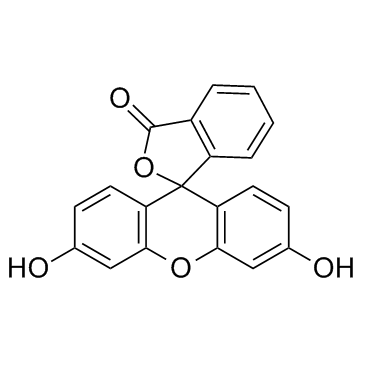N-Aminofluorescein
Modify Date: 2025-08-26 04:49:01

N-Aminofluorescein structure
|
Common Name | N-Aminofluorescein | ||
|---|---|---|---|---|
| CAS Number | 98907-26-7 | Molecular Weight | 346.33600 | |
| Density | N/A | Boiling Point | N/A | |
| Molecular Formula | C20H14N2O4 | Melting Point | N/A | |
| MSDS | N/A | Flash Point | N/A | |
Use of N-AminofluoresceinN-Aminofluorescein is a fluorescein hydrazide with spiro form, a highly selective and sensitive fluorescence probe for Cu2+. N-Aminofluorescein has no selective fluorescence response to other common metal ions, can be used for direct detection of Cu2+ in biological systems with λex/em=495/516 nm[1][2]. |
| Name | Spiro[1H-isoindole-1,9'-[9H]xanthen]-3(2H)-one, 2-amino-3',6'-dihydroxy |
|---|---|
| Synonym | More Synonyms |
| Description | N-Aminofluorescein is a fluorescein hydrazide with spiro form, a highly selective and sensitive fluorescence probe for Cu2+. N-Aminofluorescein has no selective fluorescence response to other common metal ions, can be used for direct detection of Cu2+ in biological systems with λex/em=495/516 nm[1][2]. |
|---|---|
| Related Catalog | |
| In Vitro | Guidelines (Following is our recommended protocol. This protocol only provides a guideline, and should be modified according to your specific needs). N-Aminofluorescein consists of a fluorescein moiety and a hydrazide group to recognize and bind Cu2+, can promote the hydrolysis of amide[1]. N-Aminofluorescein (FG) shows selectivity on Cu2+ and shows the absorption and emission bands at 632 nm and 515 nm in 70% aqueous HEPES buffered solution (pH 7.4) containing Cu2+[2]. Guidelines (Following is our recommended protocol. This protocol only provides a guideline, and should be modified according to your specific needs). General procedure for Cu2+ determination[1]: 1.Prepare the 1.0 mM stock solution of spiro form fluorescein hydrazide in ethanol; 2.Conduct the fluorescence-on reaction in 0.01 M Tris-HCl buffer (pH 7.2), with 10 μM N-Aminofluorescein; 3.Add an appropriate volume of sample solution with a final Cu2+ concentration of not more than 10 μM, and adjust the final volume 10 mL with 0.01 M Tris-HCl buffer (pH 7.2); 4.After 2 h, transfer a 3-mL portion of the solution to a 1-cm quartz cell, and measure the fluorescence intensity/spectrum at room temperature with λex/em = 495/516 nm and both excitation and emission slit widths of 5 nm; 5.In the meantime, prepare a blank solution containing no Cu2+ and measure with the same conditions for comparison. |
| References |
| Molecular Formula | C20H14N2O4 |
|---|---|
| Molecular Weight | 346.33600 |
| Exact Mass | 346.09500 |
| PSA | 96.02000 |
| LogP | 3.46310 |
| Precursor 0 | |
|---|---|
| DownStream 1 | |
| Spiro[isoindoline-1,9'-xanthen]-3-one, 2-amino-3',6'-dihydroxy- |
 CAS#:2321-07-5
CAS#:2321-07-5